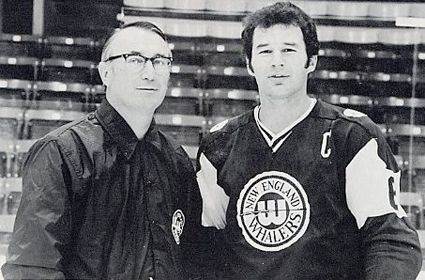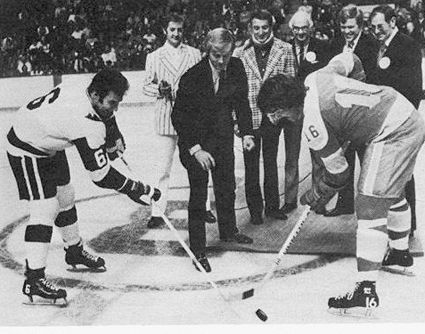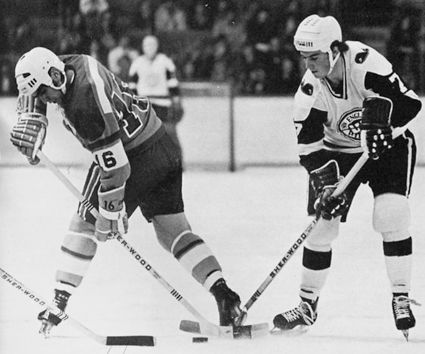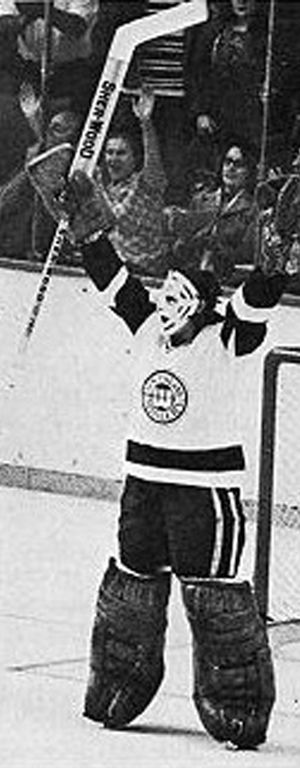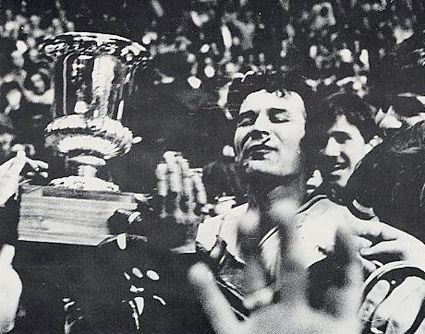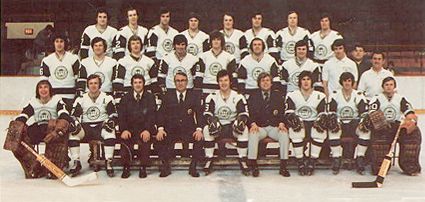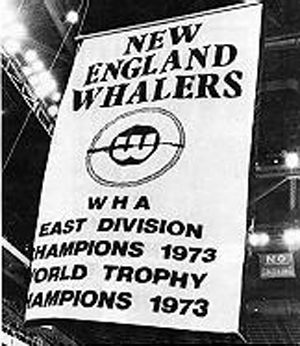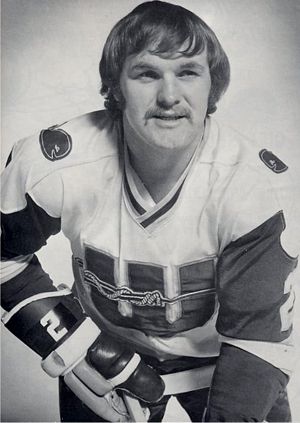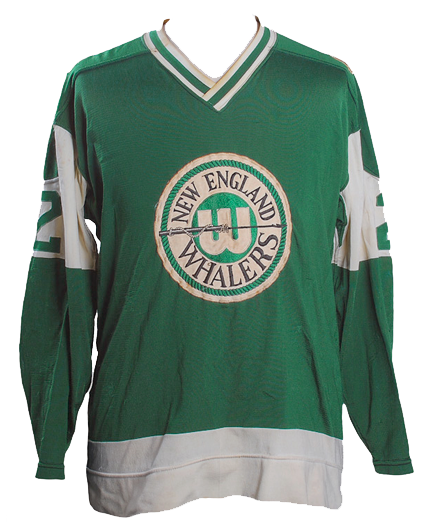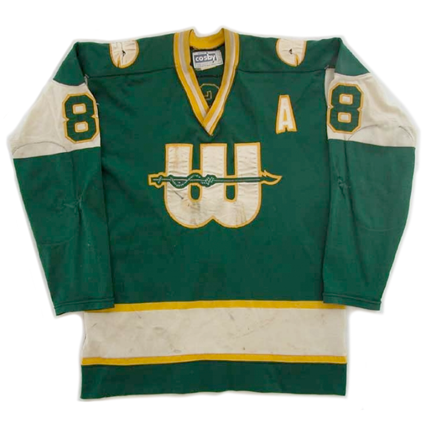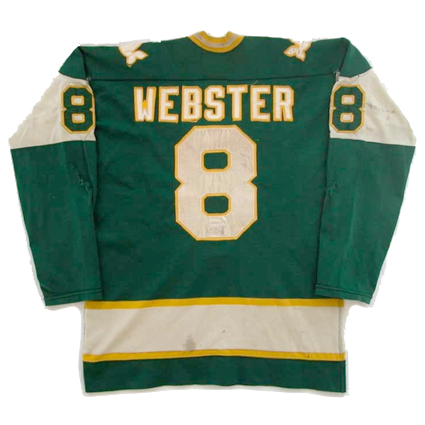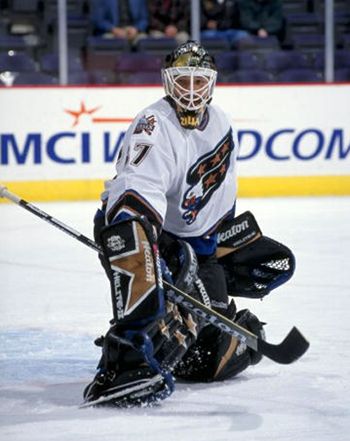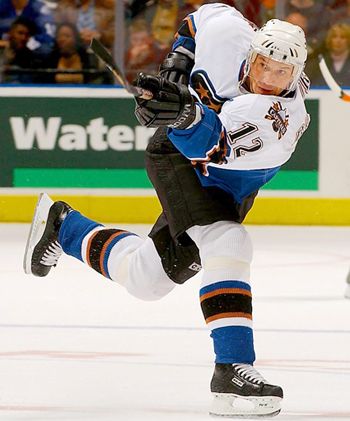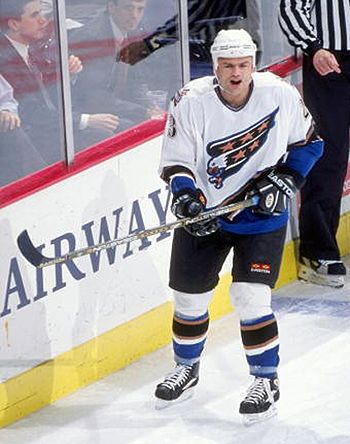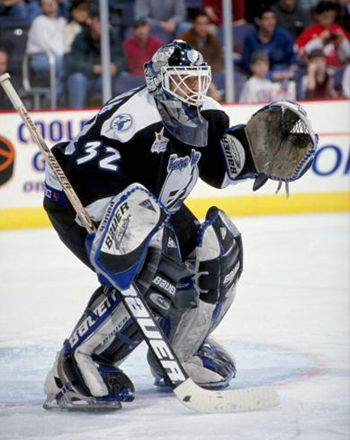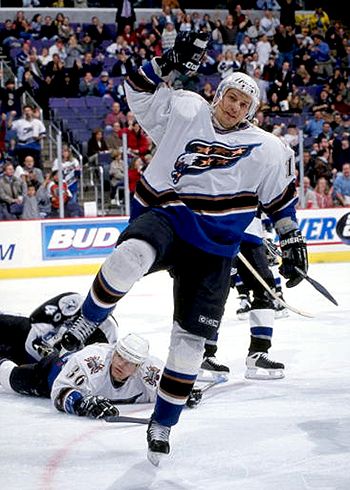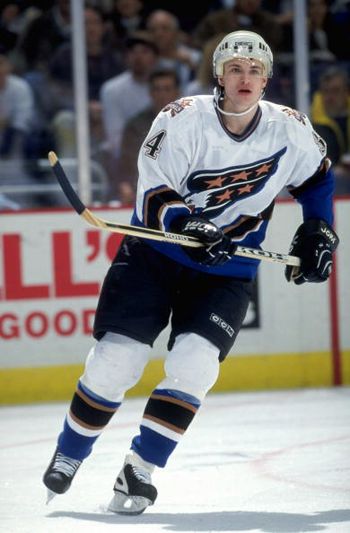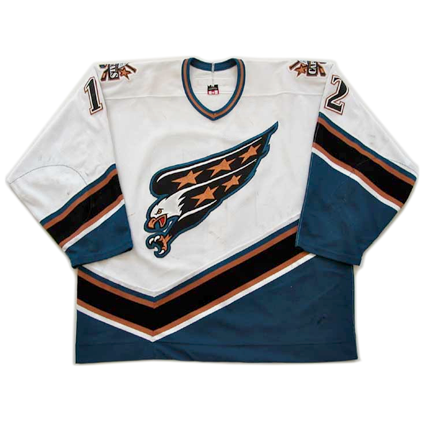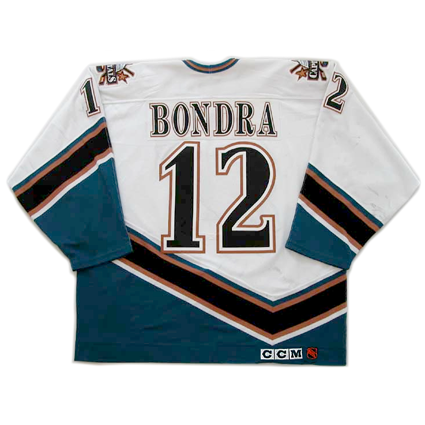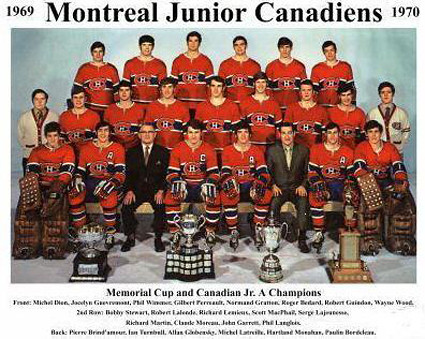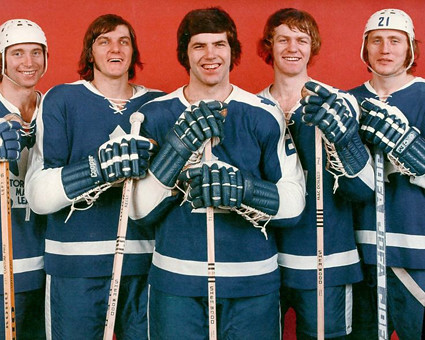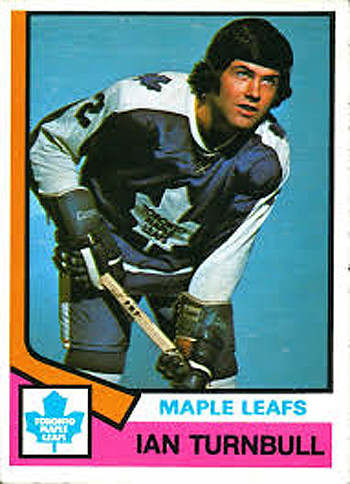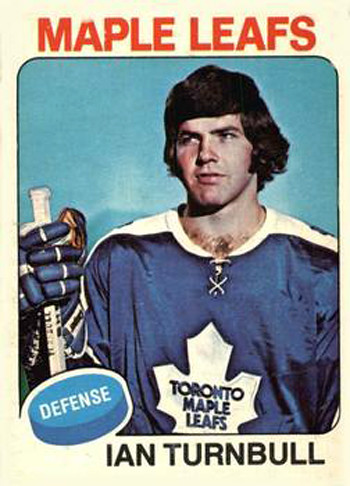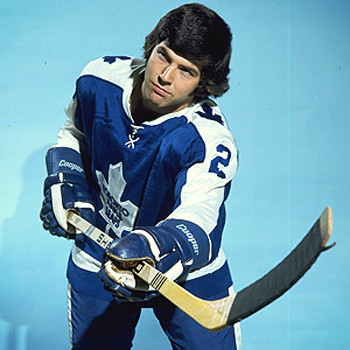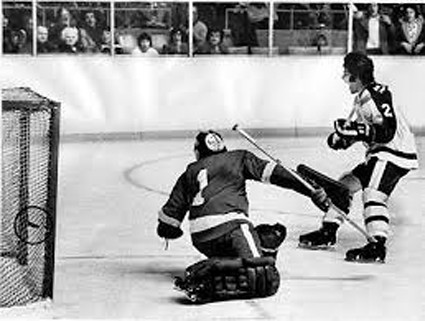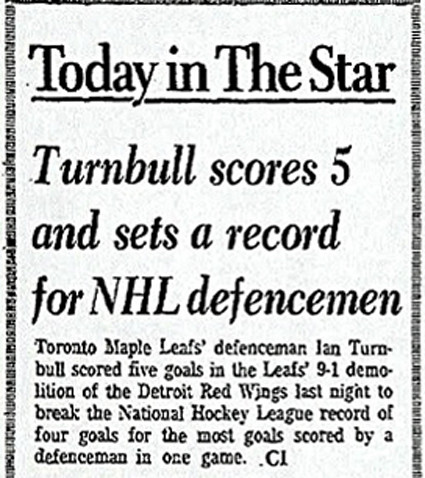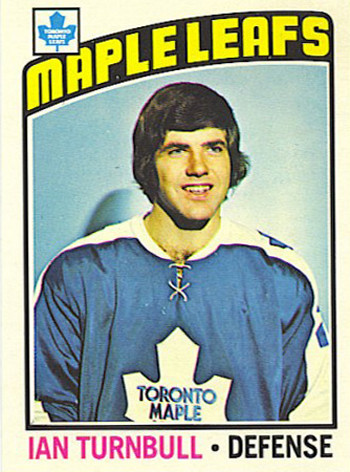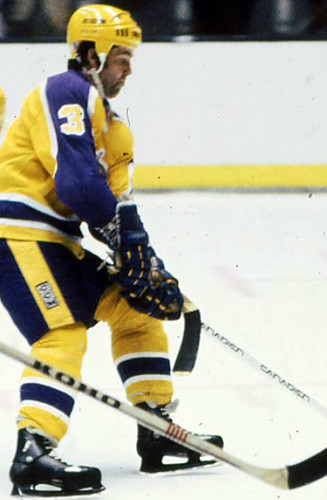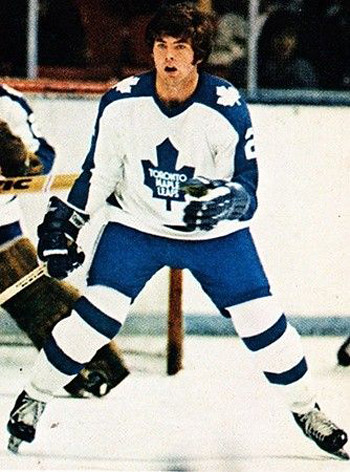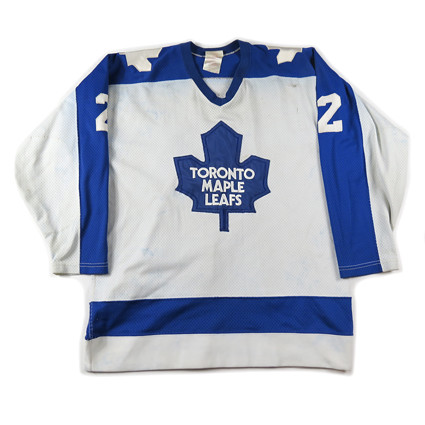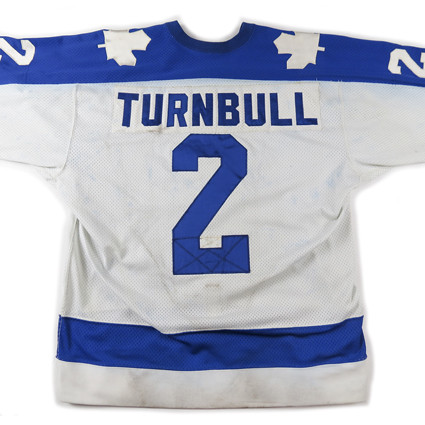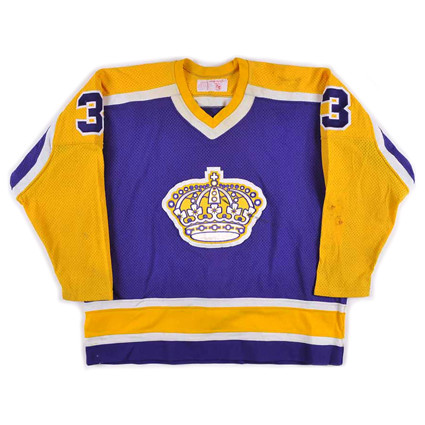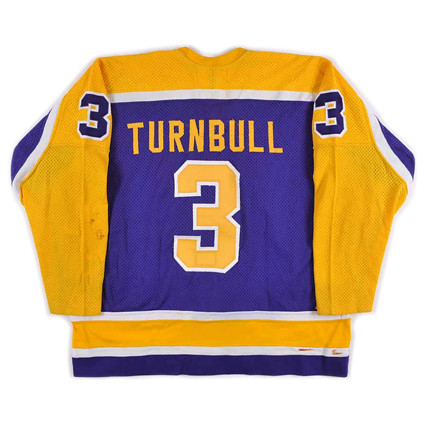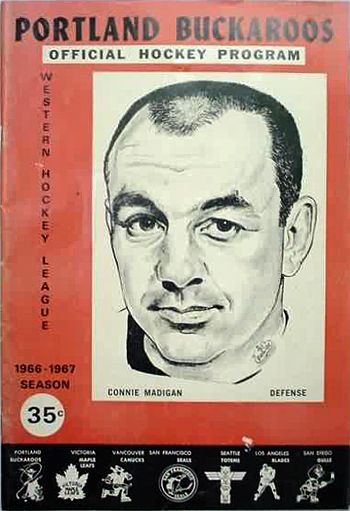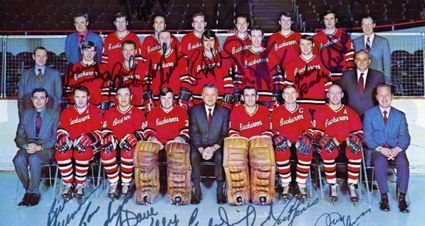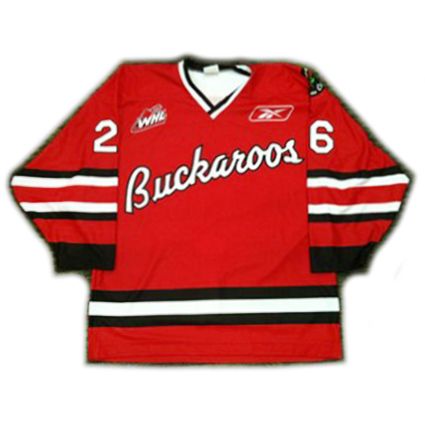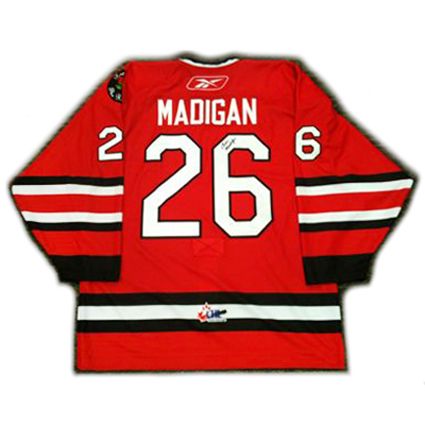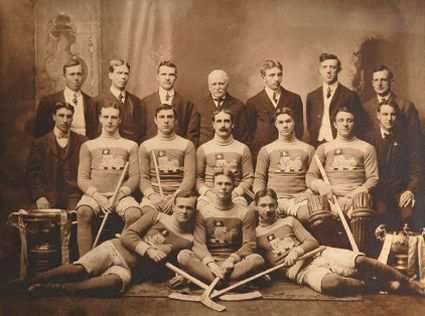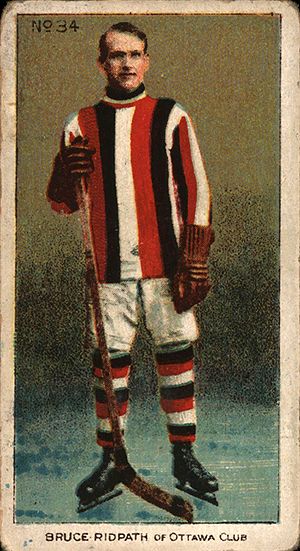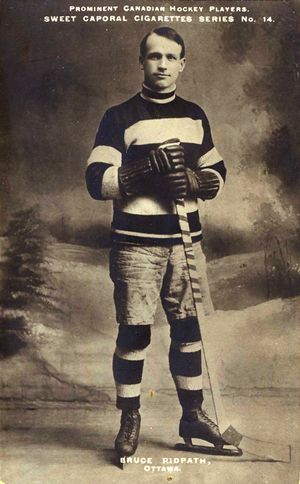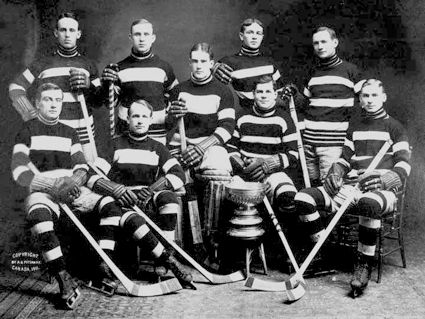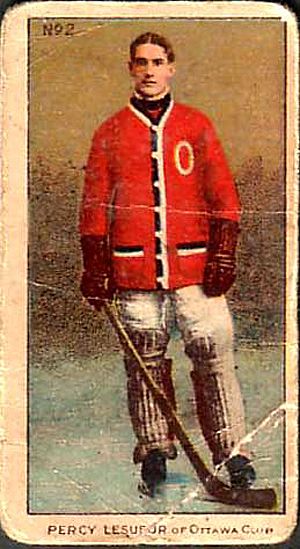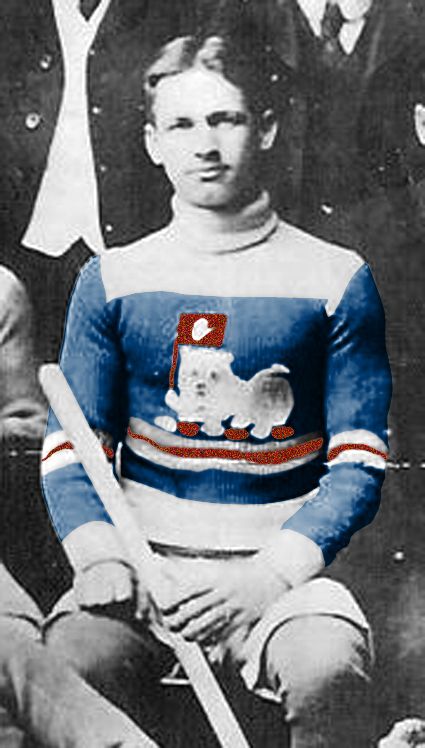Saturday, February 4, 2017
1972-73 New England Whalers Rick Ley Jersey
With the New England Patriots competing in tomorrow's Super Bowl, we thought we would take a look at another team named for New England, the New England Whalers of the World Hockey Association.
To stock their roster for the inaugural WHA season, the Whalers signed veteran Ted Green away from the Bruins to be the team's first captain.
Coach Jack Kelley and team captain Ted Green
They also lured 30 goal scorer Tom Webster away from the California Golden Seals, whose owner Charlie O. Finley refused to open the checkbook to keep several of his better players when the WHA came to raid his roster.
Rick Ley of the Toronto Maple Leafs was called upon to anchor the team's defense in front of former Pittsburgh Penguins and Detroit Red Wings goaltender Al Smith, who would eventually serve two terms with the Whalers.
The Whalers were forced to be creative in assembling the rest of their roster, as 12 WHA teams were seeking to employ roughly 250 professional players in all. Additionally, the NHL had also expanded by two clubs that season in an attempt to occupy markets the WHA might have found attractive, placing clubs on Long Island in New York and Atlanta, Georgia, meaning in actuality, 275 more players would be needed to stock an additional 14 combined rosters than the season before.
The tactic taken by the Whalers was to embrace the often overlooked American player, signing former US Olympic Hockey Team members, particularly those with ties to Boston. Larry Pleau (a Boston native) was lured away from the Montreal Canadiens, Kevin Ahearn, John Cunniff, Paul Hurley and Tim Sheehy, who all played for Boston College, and Tommy Williams, who had played for the Bruins were recruited to join the Whalers inaugural roster.
Larry Pleau scores the game winning goal against #00 Bernie Parent of Philadelphia during the Whalers first game
Jack Kelley, who had just won back to back national titles with Boston University in 1971 and 1972, was hired to coach the team. Additionally, Canadians John Danby and Ric Jordan, both of whom were members of Kelley's national championship winning Terriers, joined the Whalers along with their head coach.
The Whalers began play located in Boston, Massachusetts, dividing their home games between the Boston Arena and the Boston Garden, which was the traditional home of the Boston Bruins of the NHL since 1928. The Boston Arena, opened in 1910, is the oldest ice hockey arena still in use and was the Bruins original home and is still being used by the Northeastern Huskies of Hockey East, although it was renamed Matthews Arena in 1982.
The ceremonial opening faceoff between captain Ted Green and Philadelphia's Derek Sanderson at the Whalers first ever game. Note the Bruins logo prominent at center ice!
The inaugural Whalers season went better than anyone could have hoped for, as the Whalers won their first three games and nine of their first 13. They also posted a six game winning streak in early December to go ten games over .500 and finished the season strong with an eight game winning streak in early March, which included scoring seven goals in back to back games against Winnipeg and Minnesota. The team finished with a 46-30-2 record for 94 points, best in the league. At the conclusion of the season, Whalers forward Terry Caffery was named the league's Rookie of the Year following his 29 goal, 100 point season.
Terry Caffrey battles for the puck
In the playoffs, the Whalers defeated the Ottawa Nationals (who actually moved their playoff games to Toronto in advance of relocating there the next season, such was life in the rest of the WHA), then ousted the Cleveland Crusaders and then defeated the Winnipeg Jets (all by identical 4 games to 1 totals) to capture the Avco World Trophy as the WHA's inaugural champions.
In typical WHA fashion, fans in Boston not in attendance were unable to see the celebration, as the local TV station pulled the plug on the game with seven minutes remaining in order to begin broadcasting a tennis match! If that were not enough, the Avco World Trophy was not actually completed yet, and the team had to skate around the rink with their Eastern Conference Championship cup as a substitute!
Green celebrates with the substitute trophy following the Whalers victory
The club was led in scoring by Webster, who set career highs in goals, assists and points, with 53 goals, 50 assists and 103 points to place fourth in the WHA scoring race. Caffery's 100 points placed him second, while Pleau was next with his 39 goals and 87 points while Smith recorded 31 wins in goal.
The WHA champion 1972-73 New England Whalers
Immediately after winning the championship, the Whalers owner Howard Baldwin issued a challenge to the eventual NHL champion to meet in a one-game playoff on neutral ice for the rights to the Stanley Cup! (The sarcastic among you might suggest that winning the Stanley Cup would eliminate the need for the completion of the Avco World Trophy) Needless to say, the NHL did it's best to ignore or validate the upstart league and the game never came close to taking place.
The Whalers championship banner
The following season the Whalers again won the Eastern Division with a 43-31-4 record for 90 points, good for a second place tie in overall points.
Rick Ley in the Whalers second jerseys
Winger John French led the team in scoring with 72 points, while Webster led the team in goals in 43, fourth most in the league. Smith again reached the 30 win level in the nets for the Whalers.
The postseason did not go as planned, as the Whalers ran into a tough Chicago Cougars club, who had finish nine points back in the standings. The Whalers took Game 1 and 2 at home in Boston, but dropped the next two in Chicago. After Chicago took Game 5 in Boston, the Whalers avoided elimination with a 2-0 win back in Chicago to force a Game 7 back at home, only to fall short 3-2, bringing their season to an end.
By now, scheduling games in the Boston Garden had become increasingly difficult, as the Boston Celtics of the NBA were also in need of dates. Team ownership put a plan in place to relocate the club 100 miles west to Hartford, Connecticut, but the new Hartford Civic Center would not be ready for the start of the season, causing the Whalers to play in Springfield, Massachusetts at the Springfield Coliseum from October, 1974 until their debut in Hartford on January 11, 1975, brining to and end their time in Massachusetts.
The Whalers were 21-15-2 in their temporary home despite a schedule heavily loaded with road games, playing 25 out of their first 38 away from Springfield, including road trips of 6 and 7 consecutive games. The Whalers finished the season 43-30-5 to win their third consecutive Eastern Division title, at one point playing ten consecutive home games during a stretch of 17 out of 20 at their new home in Hartford.
The WHA lasted until the 1978-79 season, after which the Whalers and three other WHA clubs were allowed into the NHL as expansion clubs, not a merger of leagues. One of the conditions of the Whalers being granted entry into the NHL was they were forced to change their name from the New England Whalers to the Hartford Whalers at the demand of the very same Bruins they briefly shared a rink with.
Today's featured jersey is a 1972-73 New England Whalers Rick Ley jersey. This style of Whalers jersey was worn only for their inaugural, championship winning season in Boston. What made it distinctive was it's circular crest, trimmed with a rope pattern and containing the team name in the circle. A popular feature of the jersey was the secondary shoulder logo, Pucky the Whale. Ley's #2 is one of only three numbers ever retired by the Whalers.
Bonus Jersey: Today's bonus jersey is a 1974-75 New England Whalers Tom Webster jersey as worn during the team's second and final season in Boston. The Whalers simplified their crest to something more modern and graphic for their second season, taking the "W" from their original round logo with a simplified harpoon bisecting it. Pucky the Whale remained and the jerseys gained gold trim around the neck, numbers and now elevated waist stripe, which moved upwards off the bottom of the torso.
This sweater would remain unchanged even after the move to Hartford, until the 1976-77 season when the single, outlined waist stripe would change to a three stripe "Northwestern" pattern on the green road jerseys, while the home whites would take an additional season to follow suit.
Our video section today documents the inaugural New England Whalers 1972-73 championship season in five brief parts.
Labels:
New England Whalers,
WHA
Friday, February 3, 2017
1998-99 Washington Capitals Peter Bondra Jersey
It began like any other game when the Washington Capitals hosted the Tampa Bay Lightning on this date in 1999. Corey Schwab started in goal for the Lightning while the Capitals number one Olaf Kolzig took his familiar place in the crease for Washington.
14 of the 18 Capitals scored a point, led of course by Bondra's 5 points. Defensemen Johansson and Joe Reekie were both a +5. Conversely, every Tampa Bay player, save for Tucker who was even, finished the game with a minus rating with Wendel Clark and Chris Gratton getting tagged with a -4 for the game during which the last place Lightning were missing five defensemen due to injuries.
Washington failed to capitalize on a power play opportunity at 1:37 and the Lightning also could not score with their first man advantage at 8:17. Peter Bondra of the Capitals broke the stalemate at 10:40 shortly after Kelly Miller's charging penalty expired 23 seconds earlier. In fact, Miller received an assist on the goal. Despite two more power plays, Washington could not add to their lead and the period ended with the Capitals up by a goal and leading in shots by a comfortable 13-4 margin.
The well-travelled Mike Sillinger scored his fourth goal of the season from Rob Zamuner and Darcy Tucker at exactly 5:00 with both teams at even strength to tie the game at 1-1.
And then it began.
Bondra struck for the second time in the game at 9:46 to regain the lead for Washington and he completed his hat trick just 35 seconds later with an assist from Adam Oates. It was Bondra's 20th goal of the season, his eighth consecutive season of 20 goals or more.
Calle Johanson made it 4-1 for the Captials 1:29 later from Andrei Nikolishin and Brian Bellows 9th goal came just 35 seconds afterwards at 11:50 to stretch the Washington lead to 6-1.
This marked the end of the line for Schawb in the Tampa Bay goal. He was replaced by former Captial and NHL veteran Bill Ranford, who was rudely greeted by Joe Juneau's 10th goal of the season, from Bondra and Nikolishin just 1:15 after entering the game.
Bellows scored just 35 seconds after Nikolishin
This marked the end of the line for Schawb in the Tampa Bay goal. He was replaced by former Captial and NHL veteran Bill Ranford, who was rudely greeted by Joe Juneau's 10th goal of the season, from Bondra and Nikolishin just 1:15 after entering the game.
Bondra then confirmed the rout with his fourth of the game another 63 seconds afterwards from Oates and Juneau at 14:33.
James Black joined the scoring parade from Nikolishin, his third of the period, and Bellows at the 16:56 mark, the Capitals seventh even strength goal of the period.
Jaroslav Svejkovsky's third goal of the season, from Steve Konowalchuk and Jan Bulis came on the power play at 19:20 to give Washington eight goals in the second period alone and set a new NHL record for the fastest 8 goals by one team, which they did in 9 minutes and 34 seconds.
The period ended with Washington leading 9-1, with their 8 second period goals coming on 25 shots to Tampa Bay's 8. Once Bondra began the record scoring binge, the longest Washington went without a goal during the period was just 2 minutes and 24 seconds.
After the break, Washington set another record for the quickest 9 goals by one team in league history when Bellows 10th of the season, from Oates and Juneau, lit the lamp at 1:18 on the power play, giving the Capitals 9 goals in the span of 11:32.
The remainder of the game was scoreless as the Capitals cruised to a 10-1 final score and outshot Tampa Bay 46-22 for the game.
"Tonight was a night where we scored early and just kept going forward," said Bondra, who matched his goal total for the previous seven games. "I don't think I played bad before. I would hit a post. Tonight was a night when the puck went in. Everything I shot went in."
Today's featured jersey is a 1998-99 Washington Capitals Peter Bondra jersey as worn during his four goal performance during the Capitals record setting scoring binge against the Tampa Bay Lightning. While Bondra's four goal game was certainly impressive, it was not his best, as he once scored five goals in a game on February 5, 1994 in a 6-3 Washington victory over... the same Tampa Bay Lightning.
The Capitals had adopted this style of jersey, often referred to as "the screaming eagle" style in 1995 after 21 seasons wearing their original red, white and blue jerseys. This style remained in use through the 2006-07 season before a complete redesign in 2007 coinciding with the new Reebok Edge jerseys saw a return to patriotic red, white and blue colors.
First up in today's video section is a Bondra tribute video featuring lots and lots of goals.
And there was much rejoicing.
And there was much rejoicing.
Labels:
Bondra Peter,
Washington Capitals
Thursday, February 2, 2017
The NHL Record for Most Goals in a Game by a Defenseman - 1976-77 Toronto Maple Leafs Ian Turnbull Jersey
After playing three seasons for the Montreal Jr. Canadiens, highlighted by his standout 1971-72 season during which he scored 34 goals and 82 points in 63 games, defenseman Ian Turnbull moved to the Ottawa 67's, also of the Ontario Hockey Association, where he completed his junior career with 25 goals and 64 points in 51 games.
Of note, the reason the Montreal Jr. Canadiens of Quebec played in the Ontario Hockey Association was that the club wanted to play major junior hockey, which was not available in Quebec in the early 1960's when the franchise left the Quebec Junior Hockey League in 1961.
Turnbull was then drafted 70th overall by the Vancouver Blazers of the World Hockey Association and 15th overall by the Toronto Maple Leafs in the 1973 NHL Amateur Draft. Turnbull chose to sign with the Maple Leafs and immediately made the jump to the NHL, playing in all 78 games of the 1973-74 season, scoring 8 goals and 35 points as a rookie while playing with fellow NHL rookie and future Hall of Famer Borje Salming of Sweden.
One month into his 1974-75 season, Turnbull suffered a torn knee ligament which limited him to just 22 games with Toronto plus 8 rehab games with the Oklahoma City Blazers, but he did return in time to play in 7 playoff games.
Back to full health, Turnbull played 76 games in 1975-76 and reached the 20 goal mark on his way to a 56 point season and well as scoring 11 points in 10 playoff games.
By this date in 1977, Turnbull had already scored 11 goals when the Maple Leafs hosted the Detroit Red Wings at Maple Leaf Gardens.
Wayne Thomas got the start in goal for Toronto, while Ed Giacomin got the call for Detroit. The Red Wings outshot the Maple Leafs 9-8 in the first period, which passed without any scoring despite four power play opportunities, one for Detroit and three for Toronto.
After 1:55 of the second period elapsed, Turnbull started the scoring for Toronto with an even strength goal from Lanny McDonald and Salming. Pat Boutette scored for the Maple Leafs just 40 seconds later from Stan Weir, which was soon followed by Don Ashby's goal from Errol Thompson at 4:12, just 1:37 after Boutette's goal for a quick 3-0 Toronto lead.
Just over four minutes later, Tiger Williams found the back of the net with assists going to Claire Alexander and Brian Glennie to extend the Maple Leafs lead to 4. Turnbull then scored his second goal of the period unassisted at 10:26. There would be no more scoring during the second half of the period, but the five Toronto goals in eight and a half minutes were enough to end Giacomin's night as Jim Rutherford came out to tend goal for Detroit in the third period.
At the 4:58 mark of the third, Turnbull completed his first career hat trick with his 14th goal of the season, again unassisted. 1:17 later, McDonald scored his 33rd goal of the season with assists going to Ashby and Alexander at 6:15 to make it 7-0 for Toronto to the delight of the home fans.
A shade over ten minutes later, Danny Grant would spoil the shutout bid by Thomas when he scored for the Red Wings at 16:18 from Dennis Hextall and Terry Harper.
Less than a minute later at 17:10, Turnbull struck again with his fourth goal of the game from Weir and Salming.
“On our next shift, with a face–off near center–ice, B.J. [Salming] and I had a little chat,” Turnbull recalled. “He said ‘if the puck comes to me, you head straight up the middle and I’ll find you.’ So, that’s exactly what I did. Jack Valiquette won the draw back to Borje and I took off like a sprinter. He hit me with a perfect pass and I scored on a breakaway (with 1:30 left). When I turned the corner [beside the Detroit net], Salming and I were laughing like hell. How often are two defensemen able to script a play like that?” The goal made the final score 9-1 for Toronto.
Turnbull's fourth goal of the game had equaled the NHL record for Most Goals in a Game by a Defenseman, which had stood since Harry Cameron set the mark 59 years earlier on December 26, 1917 back when the NHL was merely a week old! Of note, Cameron also played for the same Toronto franchise, then known simply as the Toronto Hockey Club, setting the record in Toronto as well.
Cameron himself would equal the record on March 3, 1920, only now playing for the Montreal Canadiens. Three others would follow, first Sprague Cleghorn, also for the Canadiens, on January 14, 1922 followed by Johnny McKinnon of the Pittsburgh Pirates and Hap Day of Toronto, by now known as the Maple Leafs, during the same game, a 10-5 win by the Pirates on November 19, 1929!
Turnbull's fifth goal of the game gave him sole possession of the record, which still stands today, now 40 years later. Turnbull also became the first and only player to ever score five goals on just five shots.
Since Turnbull's record setting performance, just three defensemen have managed to score 4 in a game, Tom Bladon of the Philadelphia Flyers on December 11, 1977, none other than Turbull himself on December 12, 1981 as a member of the Los Angeles Kings and Paul Coffey on October 26, 1984 with the potent Edmonton Oilers.
Turnbull would go on to set career highs that season with 22 goals and 57 assists for 79 points, good for third on the team in scoring behind only McDonald and Darryl Sittler, who both had 90. Turnbull was also a +47 that season.
He would play five more seasons in Toronto, which included three 60 point seasons, but that would come to an end during the 1981-82 season when he was traded to the Kings after 12 games with Toronto. He would suffer a knee injury in December but eventually play 42 games for Los Angeles that season, including 11 goals and 26 points. He would also play 13 games with the New Haven Nighthawks in the American Hockey League that season.
His 1982-83 season saw Turnbull play 13 games for the Baltimore Skipjacks of the AHL and 6 games for the Pittsburgh Penguins before a back injury resulted in his retirement as a player.
Turnbull's final NHL totals were 628 games played with 123 goals and 317 assists for 440 points. He played in the 1977 NHL All-Star Game
Today's featured jersey is a 1976-77 Toronto Maple Leafs Ian Turnbull jersey as worn the night he set the NHL record for the Most Goals in a Game by a Defenseman with 5, breaking the 59 year old record of 4 first set back in 1917 and last equaled in 1929.
The Maple Leafs first wore this style jersey in 1970-71 with a lace up collar for two seasons. They then went to a v-neck collar for 1972-73 before reverting to the lace up collar for two more seasons. The v-neck returned in 1975-76 and remained through the rest of this jersey's long run through the 1991-92 season, 22 seasons in total.
Bonus jersey: Today's bonus jersey is a 1981-82 Los Angeles Kings Ian Turnbull jersey
as worn the season he scored four goals, nearly equaling his own record of 5.
The Kings wore their original simple, but loud purple and gold jerseys 13 seasons before changing to a this new style which utilized the same template as the Philadelphia Flyers where the stripe down the arms then wrapped around the cuffs at the end of the sleeves. This style was used for eight seasons before the team completely revamped their look with a new logo and adopted the black and sliver colors of the Los Angles Raiders of the National Football League to coincide with the arrival of Wayne Gretzky in Los Angeles.
Today's video section is Turnbull's breakaway fifth goal of the game to set the NHL record.
Of note, the reason the Montreal Jr. Canadiens of Quebec played in the Ontario Hockey Association was that the club wanted to play major junior hockey, which was not available in Quebec in the early 1960's when the franchise left the Quebec Junior Hockey League in 1961.
Turnbull was then drafted 70th overall by the Vancouver Blazers of the World Hockey Association and 15th overall by the Toronto Maple Leafs in the 1973 NHL Amateur Draft. Turnbull chose to sign with the Maple Leafs and immediately made the jump to the NHL, playing in all 78 games of the 1973-74 season, scoring 8 goals and 35 points as a rookie while playing with fellow NHL rookie and future Hall of Famer Borje Salming of Sweden.
Inge Hammarstrom, Bob Neely, Ian Turnbull, Lanny McDonald
and Borje Salming of the Toronto Maple Leafs
One month into his 1974-75 season, Turnbull suffered a torn knee ligament which limited him to just 22 games with Toronto plus 8 rehab games with the Oklahoma City Blazers, but he did return in time to play in 7 playoff games.
Back to full health, Turnbull played 76 games in 1975-76 and reached the 20 goal mark on his way to a 56 point season and well as scoring 11 points in 10 playoff games.
By this date in 1977, Turnbull had already scored 11 goals when the Maple Leafs hosted the Detroit Red Wings at Maple Leaf Gardens.
Wayne Thomas got the start in goal for Toronto, while Ed Giacomin got the call for Detroit. The Red Wings outshot the Maple Leafs 9-8 in the first period, which passed without any scoring despite four power play opportunities, one for Detroit and three for Toronto.
After 1:55 of the second period elapsed, Turnbull started the scoring for Toronto with an even strength goal from Lanny McDonald and Salming. Pat Boutette scored for the Maple Leafs just 40 seconds later from Stan Weir, which was soon followed by Don Ashby's goal from Errol Thompson at 4:12, just 1:37 after Boutette's goal for a quick 3-0 Toronto lead.
Just over four minutes later, Tiger Williams found the back of the net with assists going to Claire Alexander and Brian Glennie to extend the Maple Leafs lead to 4. Turnbull then scored his second goal of the period unassisted at 10:26. There would be no more scoring during the second half of the period, but the five Toronto goals in eight and a half minutes were enough to end Giacomin's night as Jim Rutherford came out to tend goal for Detroit in the third period.
At the 4:58 mark of the third, Turnbull completed his first career hat trick with his 14th goal of the season, again unassisted. 1:17 later, McDonald scored his 33rd goal of the season with assists going to Ashby and Alexander at 6:15 to make it 7-0 for Toronto to the delight of the home fans.
A shade over ten minutes later, Danny Grant would spoil the shutout bid by Thomas when he scored for the Red Wings at 16:18 from Dennis Hextall and Terry Harper.
Less than a minute later at 17:10, Turnbull struck again with his fourth goal of the game from Weir and Salming.
“On our next shift, with a face–off near center–ice, B.J. [Salming] and I had a little chat,” Turnbull recalled. “He said ‘if the puck comes to me, you head straight up the middle and I’ll find you.’ So, that’s exactly what I did. Jack Valiquette won the draw back to Borje and I took off like a sprinter. He hit me with a perfect pass and I scored on a breakaway (with 1:30 left). When I turned the corner [beside the Detroit net], Salming and I were laughing like hell. How often are two defensemen able to script a play like that?” The goal made the final score 9-1 for Toronto.
Turnbull scores his fifth goal of the game against Rutherford
Turnbull's fourth goal of the game had equaled the NHL record for Most Goals in a Game by a Defenseman, which had stood since Harry Cameron set the mark 59 years earlier on December 26, 1917 back when the NHL was merely a week old! Of note, Cameron also played for the same Toronto franchise, then known simply as the Toronto Hockey Club, setting the record in Toronto as well.
Cameron himself would equal the record on March 3, 1920, only now playing for the Montreal Canadiens. Three others would follow, first Sprague Cleghorn, also for the Canadiens, on January 14, 1922 followed by Johnny McKinnon of the Pittsburgh Pirates and Hap Day of Toronto, by now known as the Maple Leafs, during the same game, a 10-5 win by the Pirates on November 19, 1929!
Turnbull's fifth goal of the game gave him sole possession of the record, which still stands today, now 40 years later. Turnbull also became the first and only player to ever score five goals on just five shots.
Since Turnbull's record setting performance, just three defensemen have managed to score 4 in a game, Tom Bladon of the Philadelphia Flyers on December 11, 1977, none other than Turbull himself on December 12, 1981 as a member of the Los Angeles Kings and Paul Coffey on October 26, 1984 with the potent Edmonton Oilers.
Turnbull would go on to set career highs that season with 22 goals and 57 assists for 79 points, good for third on the team in scoring behind only McDonald and Darryl Sittler, who both had 90. Turnbull was also a +47 that season.
He would play five more seasons in Toronto, which included three 60 point seasons, but that would come to an end during the 1981-82 season when he was traded to the Kings after 12 games with Toronto. He would suffer a knee injury in December but eventually play 42 games for Los Angeles that season, including 11 goals and 26 points. He would also play 13 games with the New Haven Nighthawks in the American Hockey League that season.
A rare shot of Turnbull as a King
His 1982-83 season saw Turnbull play 13 games for the Baltimore Skipjacks of the AHL and 6 games for the Pittsburgh Penguins before a back injury resulted in his retirement as a player.
Turnbull's final NHL totals were 628 games played with 123 goals and 317 assists for 440 points. He played in the 1977 NHL All-Star Game
Today's featured jersey is a 1976-77 Toronto Maple Leafs Ian Turnbull jersey as worn the night he set the NHL record for the Most Goals in a Game by a Defenseman with 5, breaking the 59 year old record of 4 first set back in 1917 and last equaled in 1929.
The Maple Leafs first wore this style jersey in 1970-71 with a lace up collar for two seasons. They then went to a v-neck collar for 1972-73 before reverting to the lace up collar for two more seasons. The v-neck returned in 1975-76 and remained through the rest of this jersey's long run through the 1991-92 season, 22 seasons in total.
The Kings wore their original simple, but loud purple and gold jerseys 13 seasons before changing to a this new style which utilized the same template as the Philadelphia Flyers where the stripe down the arms then wrapped around the cuffs at the end of the sleeves. This style was used for eight seasons before the team completely revamped their look with a new logo and adopted the black and sliver colors of the Los Angles Raiders of the National Football League to coincide with the arrival of Wayne Gretzky in Los Angeles.
Today's video section is Turnbull's breakaway fifth goal of the game to set the NHL record.
Labels:
Los Angeles Kings,
Toronto Maple Leafs,
Turnbull Ian
Wednesday, February 1, 2017
1973-74 Portland Buckaroos Connie Madigan Jersey
Connie Madigan's career began in his hometown Port Arthur Bruins of the Thunder Bay Junior Hockey League in the 1952-53 season. After three seasons with the Bruins, Madigan moved up to the senior level in 1955 with the Peniction Vees of the Ontario Senior Hockey League for two seasons.
Madigan, a defenseman, also played for the Nelson Maple Leafs of the Western International Hockey League in 1958-59 where he was named to the WIHL First All-Star Team after helping lead the Maple Leafs to the Allan Cup as the champions of Canadian Senior Hockey. He then joined the Fort Wayne Komets of the International Hockey League for the following season, where he established a personal high with 57 points in 66 games.
After a second season with the Komets of Fort Wayne, Madigan moved west to play for the conventionally spelled Comets of Spokane in the Western Hockey League for the 1961-62 and 1962-63 seasons. Eventually Madigan was traded to the Los Angeles Blades after an argument with his Spokane coach that included a threat to trade Madigan, to which he responded "go ahead." Within the hour Madigan was on his way to Los Angeles!
After one season in Los Angeles, he was traded across the country to the Providence Reds of the American Hockey League. He would play in just ten games for Providence to begin the 1964-65 season before once more being traded for cash to the Portland Buckaroos back in the familiar WHL.
It was with Portland that Madigan's nomadic hockey career, which had seen him criss-crossing the North American continent would finally find a place to call home. Madigan became a stalwart on the Buckaroos blueline for the next nine seasons, never playing less than 60 games a year.
His first season with Portland would be a successful one, as the Buckaroos captured their second Lester Patrick Cup in franchise history as champions of the WHL. 1966-67 saw Madigan record his second 50 point season as a professional with 51 points and be named to the WHL First All-Star Team for the first of four consecutive seasons. Additionally, he was named the recipient of the Hal Laycoe Cup as the WHL's Outstanding Defenseman.
1964-65 WHL champion Portland Buckaroos
In 1969-70 Madigan left Portland for a ten game stint with the Dallas Black Hawks of the Central Hockey League, the fifth league he had now played in since turning professional back in 1958.
Back with Portland for the majority of the season, Madigan still had enough time to surpass the 100 penalty minute mark, keeping alive the rugged defenseman's streak that now stretched to 14th seasons and would eventually reach 18 consecutive seasons.
1970-71 would see the Buckaroos capture another Lester Patrick Cup following a season in which Madigan would establish a career high with 67 points which came in 72 games.
1970-71 WHL champion Portland Buckaroos
Following a 56 point season in 1971-72, Madigan began the season with Portland as usual, but on the final day of 1971, the unthinkable happened - he was sold.
While Madigan being traded for cash was not that unusual, as it had happened a number of times earlier in his career, the unthinkable element was to whom he was sold. The St. Louis Blues of the National Hockey League.
So it came to be on this date in 1973 that Connie Madigan of the St. Louis Blues became the oldest rookie in NHL history when he made his debut in a 3-3 tie against the Montreal Canadiens at the age of 38 years old.
At the time of his debut, his coach Jean-Guy Talbot was only two years older than Madigan and some of his teammates had not even been born yet when his career began!
Filling in for a pair of injured Blues defensemen, Madigan played in 20 games for St. Louis, scoring three assists and seeing action in five playoff games.
That would be the extent of Madigan's NHL career, as the Blues would sell him to the San Diego Gulls of the WHL for the start of the 1973-74 season. After 39 games with the Gulls, he once again returned home to Portland when he was sold yet again in February of 1974. Back with the Buckaroos he finished out the regular season and one final playoff run in the spring of 1975 before closing out his career with ten games in 1974-75 at the age of 40.
At the time of his retirement, Madigan was second in penalty minutes in minor league history.
His retirement would not be his final time on skates however, as Madigan appeared as Ross "Mad Dog" Madison in the greatest hockey movie of all time, "Slap Shot" starring Paul Newman in 1977.
Ross "Mad Dog" Madison
Today's featured jersey is a 1973-74 Portland Buckaroos Connie Madigan jersey. The Buckaroos began play in 1960-61 and took the name of a previous franchise which played in Portland from 1928 to 1941.
The team had a smashing debut, winning the WHL title in it's very first season. They went on to capture two more championships in 1965 and 1971.
They remained in the WHL until it folded in 1974. The franchise lingered on for another two seasons in first a semi-professional league and then a new amateur league, which did not last a full season, bringing and end to the Buckaroos after 15 seasons.
Bonus jersey: Today's bonus jersey is a 2011-12 Portland Winterhawks Portland Buckaroos Connie Madigan Day jersey. Sunday, March 18 2013 was declared "Connie Madigan Day" in Portland and Madigan's Buckaroos jersey was replicated for the occasion hosted by the Winterhawks of the WHL.
Today's video segment begins with a feature on Madigan presented by the Portland Winter Hawks, who saluted the Buckaroos on March 14, 2009.
Today's video segment begins with a feature on Madigan presented by the Portland Winter Hawks, who saluted the Buckaroos on March 14, 2009.
This next video feature on the Portland Buckaroos, has some classic footage that is really a joy to see, and it's followed by some former Buckaroos, including Madigan, talking about their time in Portland.
Labels:
Madigan Connie,
Portland Buckaroos
Tuesday, January 31, 2017
1912-13 Quebec Bulldogs Joe Malone Jersey
Joe Malone got his season, and the brand new National Hockey League (NHL), off with a bang when, on the day of the first games in league history, he scored five goals in the Montreal Canadiens 7-4 win over the Ottawa Senators on December 19, 1917.

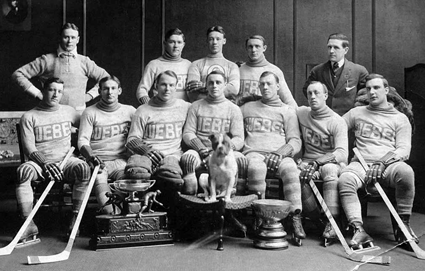



Known as "Phantom" Joe Malone because of his ability to seemingly get by opposing defensmen undetected, Malone continued to excel in during the inaugural NHL season, scoring a goal in 14 consecutive games, which still stands to this day as the second longest goal scoring streak in NHL history. Malone would wind up leading the league in scoring that season with 44 goals in what was then just a 20 game schedule.
Malone originally played for the Quebec Bulldogs in the final year of the Eastern Canada Hockey Association (ECHA) in 1909 and, giving a hint of what was to come, scored eight goals in 12 games.

The Bulldogs would move a new league, the Canadian Hockey Association, which would fold almost immediately, forcing Malone to play a season for Waterloo of the Ontario Professional Hockey League.
Back with the Bulldogs, who had now joined the National Hockey Association (NHA) for the 1910-11 season, Malone would score 9 goals in 13 games, followed by 21 goals in 18 games in 1911-12, leading the Bulldogs to the NHA championship, earning them the right to hold the Stanley Cup. The Bulldogs would face one challenge for the cup that season from the Moncton Victorias. Malone would score five goals in the two games the Bulldogs required to successfully defend the cup.
1912-13 would see a 43 goal explosion from Malone in a 20 game season as Quebec again finished atop the standings to retain the Stanley Cup. The Sydney Millionaires would challenge the Bulldogs for the the cup, but, behind Malone's nine goals in Game 1 alone, the Bulldogs would easily disptach Sydney by a score of 20-5 in the two-games, total-goals series.

The 1912-13 Bulldogs with the O'Brien Cup, as NHA champions, and
the Stanely Cup, as the best team in Canada.
After four more seasons with Quebec in the NHA, the majority of the club owners in the NHA elected to suspend league operations and form a new league, the NHL, in order to distance themselves from unwanted owner Eddie Livingstone. The Bulldogs were invited to participate in the new league but, facing financial difficulties, suspended operations for two seasons. As a result, their players were distributed among the other remaining clubs, and Malone was claimed by the Montreal Canadiens for the 1917-18 season.

Paired with future Hall of Famers Newsy Lalonde and Didier Pitre, Malone would shift to left wing and lead the league in scoring, with 48 points, and goals, with 44 in 20 games. His 44 goals set a single season record that would stand for 27 years until finally surpassed by Maurice Richard during a 50 game season in 1945. When Richard scored his 45th goal to set the new record, Malone was present to congratulate Richard and present him with the record-breaking puck.
In addition to his five goal game on opening night, Malone would repeat the feat twice more during the season and remains the only person to have scored five goals in a game more than once during a single season, let alone three times.
His second season with the Canadiens was limited due to Malone landing a better paying job in Quebec City. Including the playoffs, he would only play 13 games that season, which saw him score 12 times.
With the Quebec Bulldogs franchise revived for the 1919-20 season, Malone returned to Quebec, now renamed the Athletics although many still referred to them as the more familiar Bulldogs. He led the league with 39 goals (89% of the team's 44 goal total for the entire season!) in 24 games, which included his NHL record setting seven goals on this date in 1920 in a game versus the Toronto St. Patrick's, a record which still stands today.
Malone started off the game with his first goal at the 6:50 mark of the first period followed by Reg Noble evening the score at 1-1 with a goal at the halfway mark of the period. Quebec then added a pair of goals at 15:25 and 16:05 before Toronto responded with their second goal at 17:10 as the first period ended with the score at 3-2 for Quebec and Malone having scored just once, giving little indication of what was to follow...
Same has he did in the first period, Malone scored the first goal of the second, needing just 55 seconds to beat Mike Mitchell for the second time. Corb Denneny responded with a St. Patricks goal four minutes later, but Malone completed his hat trick at 10:18 to restore the Bulldogs two goal margin. Noble scored again for Toronto at 13:58 but Malone's fourth goal of the game and third of the period came at 18:18 for a 6-4 Quebec lead after two periods.
Howard Lockhart replaced Mitchell in goal for Toronto, who pulled back to within one yet again when Mickey Roach scored at 2:40. Quebec replied yet again at 4:10 only to have the St. Patricks Cully Wilson score just 30 seconds later to make the score 7-6 for Quebec. Lockhart had managed to keep the red hot Malone off the scoreboard for the first half of the third period, but at exact the 10 minute mark, Malone scored his fifth goal of the night which was followed by completing his second hat trick with his sixth goal just two minutes later. With just 45 seconds left in the game, Malone entered the NHL record books with his seventh goal of the night at third of the period against Lockhart for a final score of 10-6. During the game, Malone actually had an eighth goal negated by an offside call.
Malone also had a six goal night to close out the schedule on March 10th and finished the season with ten assists to lead the NHL in scoring with 49 points.
Malone started off the game with his first goal at the 6:50 mark of the first period followed by Reg Noble evening the score at 1-1 with a goal at the halfway mark of the period. Quebec then added a pair of goals at 15:25 and 16:05 before Toronto responded with their second goal at 17:10 as the first period ended with the score at 3-2 for Quebec and Malone having scored just once, giving little indication of what was to follow...
Same has he did in the first period, Malone scored the first goal of the second, needing just 55 seconds to beat Mike Mitchell for the second time. Corb Denneny responded with a St. Patricks goal four minutes later, but Malone completed his hat trick at 10:18 to restore the Bulldogs two goal margin. Noble scored again for Toronto at 13:58 but Malone's fourth goal of the game and third of the period came at 18:18 for a 6-4 Quebec lead after two periods.
Howard Lockhart replaced Mitchell in goal for Toronto, who pulled back to within one yet again when Mickey Roach scored at 2:40. Quebec replied yet again at 4:10 only to have the St. Patricks Cully Wilson score just 30 seconds later to make the score 7-6 for Quebec. Lockhart had managed to keep the red hot Malone off the scoreboard for the first half of the third period, but at exact the 10 minute mark, Malone scored his fifth goal of the night which was followed by completing his second hat trick with his sixth goal just two minutes later. With just 45 seconds left in the game, Malone entered the NHL record books with his seventh goal of the night at third of the period against Lockhart for a final score of 10-6. During the game, Malone actually had an eighth goal negated by an offside call.
Malone also had a six goal night to close out the schedule on March 10th and finished the season with ten assists to lead the NHL in scoring with 49 points.
Unfortunately, the Athletics were a horrible defensive team and gave up an average of over seven goals a game, including an NHL record 16 allowed against Montreal that still stands today, something not even the scoring exploits of the prolific Malone could overcome. With Quebec finishing last in the league with matching 2-10 records in both halves of the season, the struggling team was then sold to an ownership group who relocated the franchise to Hamilton, Ontario and renamed them the Tigers. Malone managed to finish fourth in league scoring while putting up seasons of 28 goals in 20 games in 1920-21 and 24 goals in 24 games the following year despite the Tigers being anchored to the bottom of the standings both seasons.

Malone was traded to the Montreal Canadiens for the 1922-23 season, but scored but a single goal in 20 games in a backup role. He played 10 games the following season without scoring before retiring on January 23, 1924.
In 15 seasons throughout various leagues, Malone scored 343 goals in 275 games and was inducted into the Hockey Hall of Fame in 1950.
Today's featured jersey is a 1912-13 Quebec Bulldogs Joe Malone jersey. from the Bulldogs back to back NHA championships, which also included a pair of successful defenses of the Stanley Cup. They originally wore the horizontally striped jerseys shown in the hockey card above, followed by a jersey with a large "Q" on the front. If you look closely at the team photo above, that style jersey is being worn by the player in the center of the back row, although it is rather obscured.
The Bulldogs then changed to today's featured jersey with "QUEBEC" boldly emblazoned across the front, which was worn during their greatest successes in 1912 and 1913.

Today's video is a look back at the history of the Quebec Bulldogs.
Labels:
Malone Joe,
Quebec Bulldogs
Monday, January 30, 2017
1908-09 Toronto Marlboros Bruce Ridpath Jersey
After playing junior hockey in 1904, Bruce Ridpath joined the Toronto Marlboros of the Ontario Hockey Association in 1905 as an amateur. He turned professional in 1906, playing in eight games and scoring 17 times for the Marlboros.
He helped lead the club to the league championship in 1908, which gave the Marlboros the opportunity to face the Montreal Wanderers in a one game challenge for the Stanley Cup. While Toronto would lose the game 6-4, Ridpath was able to score a goal during the contest.
On this date in 1909, Ridpath had the best game of his career when he scored seven times in a 15-10 Toronto win over Brantford. Later that same season, Ridpath played with the Cobalt Silver Kings, who would be one of the founding members of the National Hockey Association the following season.
Ridpath did not return to Cobalt for the 1909-10 season, as he had signed with the Ottawa Senators, who were also members in the new NHA along with the Haileybury Comets, Renfrew Creamery Kings, Montreal Shamrocks, Montreal Wanderers and a brand new club, the Montreal Canadiens.
As the Senators were the holders of the Stanley Cup at the time Ridpath joined the club, they had to endure a pair of challenges for the cup while in the middle of their NHA regular season schedule. The first challenge was from Edmonton of the Alberta Amateur Hockey Association, who they turned back in Game 1 by a score of 8-4 with Ridpath contributing a goal. The second match two days later saw Ottawa rack up 13 goals to Edmonton's 7, with Ridpath netting three goals in the Senators successful defense.
The Senators lost control of the cup when they had to relinquish it to the NHA league champion Wanderers, but Ridpath finished second in league in scoring with 15 goals in 12 games behind only Senators teammate Marty Walsh.
Ottawa rebounded in 1910-11 by taking the NHA championship, thanks to a 13-3 record and scoring a league best 122 goals, which was 31 more than the next closest team - quite a margin in a 16 game season! Ridpath came in third in scoring for the Senators and fourth in the league with 22 goals in those 16 games.
Once more in control of the Stanley Cup as league champions, Ottawa fended off two challenges for the cup, first a 7-4 owner Galt, with Ridpath scoring twice, and a 13-4 drubbing of Port Arthur, during which Ridpath again contributed two goals in defense of the cup.
Ridpath missed the entire 1911-12 season after suffering a fractured skull when hit by a car in downtown Toronto in November of 1911. He survived his life-threatening injuries and the Toronto Blueshirts wanted Ridpath to suit up for them, but his vision never sufficiently recovered enough for him to return to the ice. Benefit games were held in his honor to help him pay his medical bills in both Ottawa and Toronto due to his popularity.
While he played right wing, Ridpath designed a popular style of early shin pads for goalkeepers that were widely worn in the early days of professional hockey.
Today's featured jersey is a 1908-09 Toronto Marlboros Bruce Ridpath jersey as worn the day he scored 7 goals in a single game.
The Toronto Marlborough Athletic Club was founded in 1903 and operated several clubs - minor, junior and senior teams. The junior club won seven Memorial Cups and sent over 180 played to the NHL as an affiliate of the Toronto Maple Leafs, including six Hall of Famers. The senior team competed for the Stanley Cup in 1904 and won the Allan Cup in 1950 as the senior champions of Canada.
The 1905 OHA champion Toronto Marlboros
He helped lead the club to the league championship in 1908, which gave the Marlboros the opportunity to face the Montreal Wanderers in a one game challenge for the Stanley Cup. While Toronto would lose the game 6-4, Ridpath was able to score a goal during the contest.
On this date in 1909, Ridpath had the best game of his career when he scored seven times in a 15-10 Toronto win over Brantford. Later that same season, Ridpath played with the Cobalt Silver Kings, who would be one of the founding members of the National Hockey Association the following season.
Ridpath did not return to Cobalt for the 1909-10 season, as he had signed with the Ottawa Senators, who were also members in the new NHA along with the Haileybury Comets, Renfrew Creamery Kings, Montreal Shamrocks, Montreal Wanderers and a brand new club, the Montreal Canadiens.
As the Senators were the holders of the Stanley Cup at the time Ridpath joined the club, they had to endure a pair of challenges for the cup while in the middle of their NHA regular season schedule. The first challenge was from Edmonton of the Alberta Amateur Hockey Association, who they turned back in Game 1 by a score of 8-4 with Ridpath contributing a goal. The second match two days later saw Ottawa rack up 13 goals to Edmonton's 7, with Ridpath netting three goals in the Senators successful defense.
Ridpath in the unusual vertically striped Senators jersey of 1909-10
The Senators lost control of the cup when they had to relinquish it to the NHA league champion Wanderers, but Ridpath finished second in league in scoring with 15 goals in 12 games behind only Senators teammate Marty Walsh.
Ottawa rebounded in 1910-11 by taking the NHA championship, thanks to a 13-3 record and scoring a league best 122 goals, which was 31 more than the next closest team - quite a margin in a 16 game season! Ridpath came in third in scoring for the Senators and fourth in the league with 22 goals in those 16 games.
Ottawa would return to their customary horizontal stripes in 1910-11
Once more in control of the Stanley Cup as league champions, Ottawa fended off two challenges for the cup, first a 7-4 owner Galt, with Ridpath scoring twice, and a 13-4 drubbing of Port Arthur, during which Ridpath again contributed two goals in defense of the cup.
Ridpath, front row second from the left, and the
1910-11 Ottawa Senators with the diminutive Stanley Cup
1910-11 Ottawa Senators with the diminutive Stanley Cup
Ridpath missed the entire 1911-12 season after suffering a fractured skull when hit by a car in downtown Toronto in November of 1911. He survived his life-threatening injuries and the Toronto Blueshirts wanted Ridpath to suit up for them, but his vision never sufficiently recovered enough for him to return to the ice. Benefit games were held in his honor to help him pay his medical bills in both Ottawa and Toronto due to his popularity.
While he played right wing, Ridpath designed a popular style of early shin pads for goalkeepers that were widely worn in the early days of professional hockey.
Senators teammate Percey Lesueur wearing an early style of
goalkeeper shin pads designed by Ridpath
goalkeeper shin pads designed by Ridpath
Beyond his hockey career, Ridpath was also a member of the Toronto Canoe Club and was known as a canoe racer and stunt paddler, who performed shows around the globe!
Ridpath suffered a stroke in 1925 and died young at the age of 40.
Today's featured jersey is a 1908-09 Toronto Marlboros Bruce Ridpath jersey as worn the day he scored 7 goals in a single game.
The Toronto Marlborough Athletic Club was founded in 1903 and operated several clubs - minor, junior and senior teams. The junior club won seven Memorial Cups and sent over 180 played to the NHL as an affiliate of the Toronto Maple Leafs, including six Hall of Famers. The senior team competed for the Stanley Cup in 1904 and won the Allan Cup in 1950 as the senior champions of Canada.
Labels:
Ridpath Bruce,
Toronto Marlboros
Subscribe to:
Comments (Atom)

